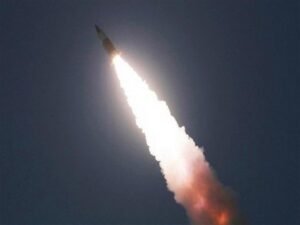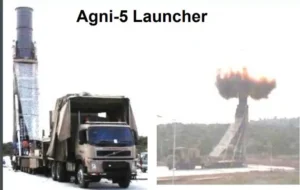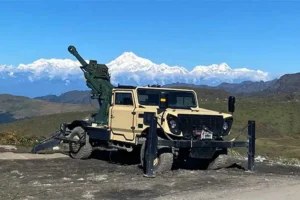Several years after the Russian Sukhoi Su-33 fighter jet crashed near the Syrian coast as it attempted to land on aircraft carrier Admiral Kuznetsov, new footage published online showed a compelling new perspective of its aftermath.
Su-30MKI: India Plans $7.5B Modernization Drive For Its Flankers; Sadly No Changes To Engine, Airframe
Russia’s Sukhoi-33 fighter jet crashed in the Mediterranean while landing on Admiral Kuznetsov aircraft carrier in early December 2016.
At the time, the Russian Ministry of Defense notified: “After performing a combat mission over Syria, a Sukhoi-33 fighter jet overran the runway while trying to land on The Admiral Kuznetsov aircraft carrier. The arresting cable’s rupture was the reason.”
Additionally, the Russian MoD informed the media that the pilot successfully abseiled and was immediately put on board the aircraft carrier by the search and rescue team. It also said that it was business as usual on the aircraft carrier. “Deck aircraft keep performing their missions,” the report said.
The crash landing, however, raised several questions about Russia’s overall naval aviation capabilities since it came just weeks after a MiG-29K aircraft had met with a similar fate. The aftermath of the Su-33 crash landing was never shown by Moscow before. Only now, the video casually appeared on the internet seven years later.
Captured on a hand-held camera or a smartphone from Admiral Kuznetsov, the video shows the Su-33 still drifting in the Eastern Mediterranean Sea after the crash. The large fighter’s twin vertical tail fins can be seen sticking out of the water in the footage as the ship goes by.
The video, taken just seconds after the aircraft went into the sea, shows the pilot still near the canopy and swimming towards his life raft, after which he was rescued from the water by a chopper hovering overhead.
Shortly after, the pilot was held up in the air by the helicopter as the footage clip came to an end, and the ship from which the video was taken passed. Additionally, it appears that when the pilot was raised, he got entangled in the parachute’s ropes.
Video leaked after 7 years! Occured on 3 December 2016, a Su-33 multirole fighter jet of #Russia Navy crashed into #MediterraneanSea while its pilot was attempting to land on the Admiral Kuznetsov aircraft carrier near the coast of #Syria. This video shows seconds after the… pic.twitter.com/YuvMYlDZF0
— Babak Taghvaee – The Crisis Watch (@BabakTaghvaee1) October 2, 2023
As per reports from the time of the crash, one of the carrier’s cross-deck pendants, or wires, snapped immediately after a Su-33’s tailhook caught it upon touchdown, causing the catastrophe. The Su-33 was only partially slowed by the wire before it snapped, thus lacking the energy to bolter and take off again, resulting in the crash.
The wreckages of the Su-33 and MiG-29KR that crashed that year were later discovered by Russia’s espionage and ‘research’ ship Yantar, and the sensitive electronics still aboard the aircraft were likely removed or destroyed. On its part, Kuznetsov has been undergoing an overhaul since 2017.
The crash of the Su-33 brought into focus the capabilities of this aircraft, with critics in the West highlighting its shortcomings. Some reports went so far as to call into question the skills of the naval aviators, lamenting that the Russian Navy does not have qualified and skilled aviators.
Su-33, The Chink In Russian Navy’s Armor
The Sukhoi Su-33, originally known as the Su-27K, is a Soviet/Russian twin-engine all-weather air superiority fighter built for carrier operations.
The Su-33 has a stronger undercarriage and structure, foldable wings, and stabilators—all of which are designed for aircraft carriers. With canards and broader wings than the Su-27, the Su-33 has a slower stall speed. The Su-33 is air refueled and has dual nose wheels and upgraded engines.
The fighter entered service in August 1998. Sales to China and India were attempted, and the Russian Navy eventually ordered the MiG-29K as a replacement in 2009 with plans to retire the Su-33 once they reached the end of their service life. The Su-33, however, has remained in service.

In essence, the MiG-29K and Su-33 have traditionally been competitors, although the Su-33 is more capable due to its larger combat flight radius, increased cargo capacity, and ability to maintain station for longer periods.
For the larger size, the Su-33’s wingtips may fold upward to reduce the aircraft’s footprint while parked, which is helpful for storage. However, the size of the Su-33, which is substantially larger than the MiG-29K, is one of its major drawbacks. The Admiral Kuznetsov, Russia’s sole aircraft carrier, can accommodate more MiGs than Sukhois due to the difference in their sizes.
The Su-33 was not only “too big” for comfortable mass operation on Russia’s Admiral Kuznetsov carrier but lacked the full range of payload delivery features necessary to fulfill its purpose.
Writing for The National Interest last year, defense writer Caleb Larson argued, “Though a reasonably capable naval fighter on paper, the Su-33 is hampered by its engines and insufficient production numbers. Given the state of Russia’s Navy and that they sail just a single, unreliable aircraft carrier, the Su-33 may not stay in service for much longer.”
Due to these issues, there has been a movement within the Russian Navy to switch out many of the Su-33s currently in service with Mikoyan Mi-29Ks. These aircraft are far more capable of ground strikes and have a wider variety of standoff missiles and guided bombs despite being less maneuverable and lesser range than the Su-33.
The MiG-29K is equipped with low observability technologies, electronic countermeasures, and an advanced radar system to support its ground-strike capability. Additionally, the MiG is lighter and smaller, making it better suited for use from a carrier. The aircraft also has lower production and maintenance expenses.
The Su-33 is currently undergoing a modernization program. Major General Igor Kozhin, chief for aviation with the Russian Navy, announced in 2020 that Russia is upgrading some of its Sukhoi Su-33 carrier fighters, specifically, those airframes that have sufficient lifetime remaining, to keep them operational until 2025.
Source link








